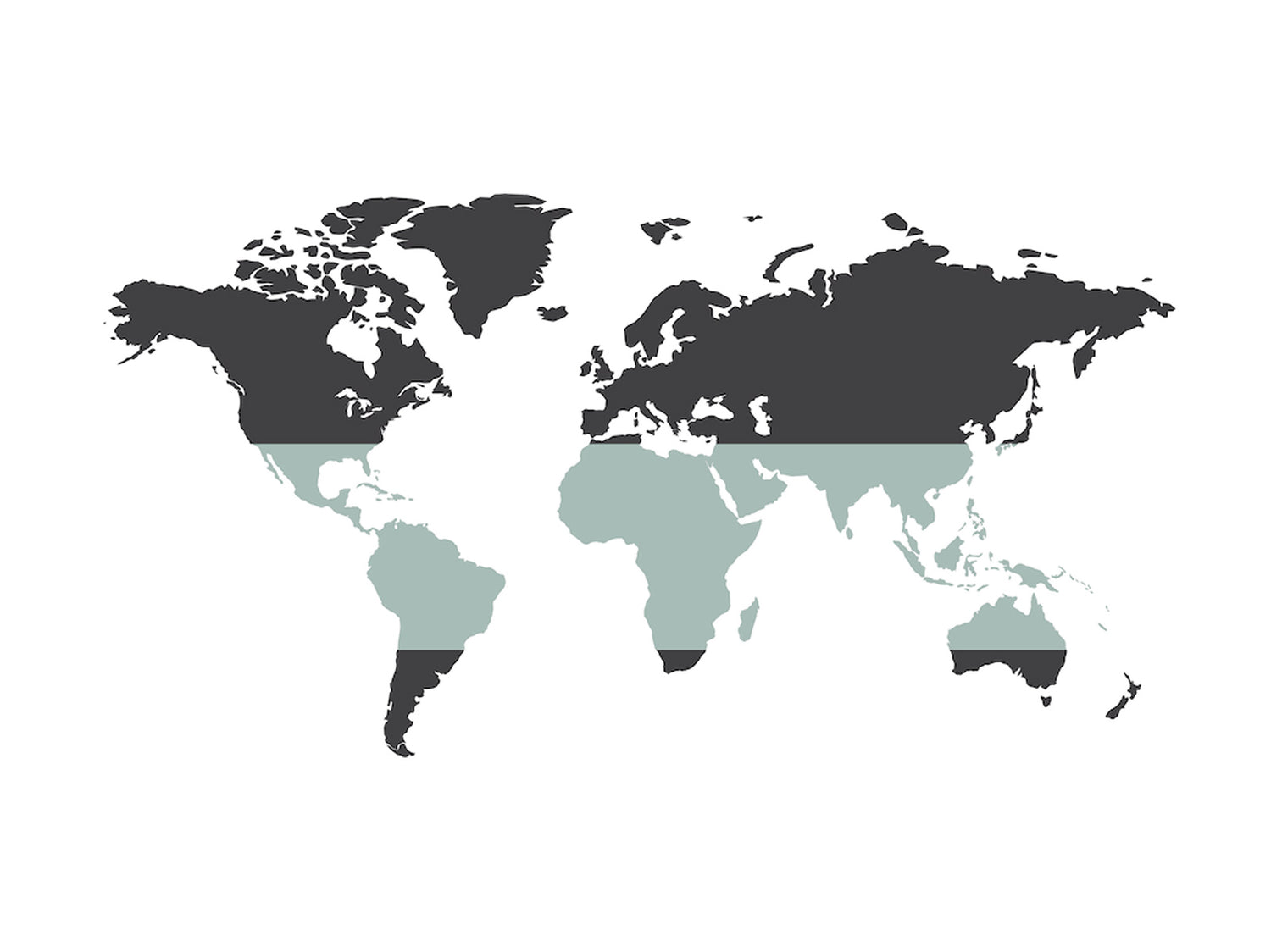So where are these coffee planted? There’s this thing called a “coffee belt”. The coffee belt is where the world’s coffee is grown. It passes through some 70 countries, which have tropical climates that provide rich environments that are perfect for growing coffee.
In very general terms, certain flavors are associated with particular continents and regions.
Picture an imaginary strip that runs through the middle of the planet, from north to south, approximately 3,200 miles (5,100km). It crosses through five continents, which are South America, North America, Africa, Asia and Oceania. However, Oceania produces very little coffee in comparison to the other four(4) continents.
Of the 70 or so countries that the coffee belt passes through, only 44 produce coffee in any significant quantities.
While these regions all share a tropical climate, their lands each have unique characteristics that influence the flavor profiles of the coffee they produce. Even different regions within a single continent—or different farms within a region—can produce coffees that are quite different.
The major regions can be seen on our coffee belt map (above) and also listed below, with the taste qualities that coffee experts typically associate with their beans.

Credits: https://www.specialtycafetiere.com/single-origin-coffee-and-mixed-blend/
Yes, you would probably think by now it’s sounding like wine, with characteristics associated with the terroir in which the grapes are grown, and so it is with coffee.
The coffee plant needs a very specific set of conditions if it’s to survive and thrive, and this is where the coffee belt comes in. The geographical location of the coffee belt is special because:
1. There is sufficient rain with distinct dry seasons.
2. The climate has moderately sunny days with cool and stable temperatures.
3. There are high enough altitudes for the coffee plants to thrive.
4. The soil is fertile for coffee plants.
While the growing conditions are similar between the countries within the coffee belt, the variations in soil, temperature, rainfall and altitude all greatly affect the flavour of the beans that the coffee plant produces.
Do coffee bean grow outside of the coffee belt?
Yes, whilst coffee is able to grow outside of the coffee belt, the coffee that is produced outside of the belt is nowhere near as good because those regions lack the fundamentals essential for the coffee plant.
So what makes the coffee in the coffee belt special?
The climate within the coffee belt provides optimum conditions for growing coffee. Coffee plants require very specific needs if they’re to produce good-quality coffee. Let’s take a look at them.
Rainfall
Coffee trees need moist, tropical climates that have distinct dry and wet seasons. A lot of coffee farmers rely on rainfall as their only source of water, so the wet season provides the vast quantities of coffee plants with the water that they need to survive.
The dry season provides the opportunity to harvest the coffee cherry fruits that house the coffee beans. A coffee’s harvest season lasts for two to three months during the dry season, and the cherries will be picked several times over those months as they continue to ripen.
Whilst most countries have a single harvest season, some countries such as Colombia have a second, smaller harvest season.
Temperature
Coffee plants need stable temperatures due to their sensitivities to both extreme cold and heat. Many coffee plants are not able to tolerate huge fluctuations in temperature, needing year-round temperatures between 15 – 30°C (59 – 86°F).
Another issue is that certain coffee species dislike too much exposure to sunlight. In order to protect the coffee plants, some farms use the protection of forest trees to shade the coffee plants.
Coffee grown under shade has other benefits such as discouraging weed growth, providing protection from frost, and increasing the number of pollinators, which results in greater quantities of coffee cherry fruits.
Coffee grown in the shade also takes longer to ripen, creating a more complex coffee as the natural fruit sugars have more time to develop.
As coffee is grown near the equator, the countries that produce coffee are some of the hottest in the world. Because of this, most coffee is grown at high altitudes where the climate is cooler and more stable.
Altitude
Most of the world’s coffee is grown between 1000 – 2000m (3300 – 6600ft) above sea level. The temperatures at these altitudes do not change a great deal between the maximum highs and lows, which is perfect for the coffee plant.
Altitude is also vitally important when the plant has low levels of caffeine as there is less chance of attack from pests because fewer reside at elevation.
Coffee grown at altitude also gives coffee a desirable acidity like that found in wines. That may come as a surprise to you due to the misnomer that coffee is inherently bitter.
Soil
Soil plays a huge role in a coffee planet’s survival as it provides the necessary nutrients that are not found from air and water.
Coffee is able to grow in a variety of soils, but the ideal types are fertile volcanic red earth or deep sandy loam.
A lot of the countries in the coffee belt are part of the Ring of Fire. The volcanic activity found there contributes to the richness of the soil that the coffee plants thrive in.
For coffee trees to grow, it’s important that the soil is well-draining. Soil naturally holds or drains water, depending on its pore space, which means that heavy clay or heavy sandy soils are inadequate.
As well as drainage, the texture of the soil also impacts the ability of coffee plants to withstand dry seasons, because water that is held deep within the soil is used over periods of low rainfall.
One of the most important nutrients for growing coffee is nitrogen. Nitrogen is used for essential functions such as photosynthesis and new tissue production, as well as other key processes.
The pH of the soil is also another important factor in the growth of coffee plants. Many tropical or semi-tropical coffee-growing regions of the world have slightly acidic soil, which is favorable for growing coffee.
Which countries produce the best coffee?
The countries that produce the best coffee is the world are those that grow the arabica variety. Arabica is grown in greater quantities in the Americas and Africa. In no particular order, and with no intention to represent the every coffee expert out there, below are some of the origins of what we consider the best.
Colombia
Colombian coffee makes up eight percent of the world’s coffee, all of which is the superior arabica variety. Not only is it a coffee-producing behemoth, but the geography means that Colombia produces some of the best coffee on the planet.
Colombian coffee is grown at very high altitudes in nutrient-dense, volcanic soil, which is why it’s so delicious. And with Colombian coffee, there’s something to please everyone.
From the more subtle chocolate and nut flavours that are also common to Brazilian coffees, there are the intensely fruity and floral coffees that display an incredible acidity only found with high altitude coffee.
The fact that the coffee-growing regions of Colombia are made up of smaller farms means that the emphasis is more on quality than quantity.
Guatemala
Every Spanish speaking country in Central America produces delicious coffee, but Guatemalan coffee really is something special.
97 percent of the coffee produced in Guatemala is of the arabica variety, which tells you why it’s so good. Just as with Colombian coffee, the coffee in Guatemala is grown in volcanic soil.
Guatemalan coffee exhibits a wide range of flavours, from the bold and heavy, chocolatey coffees to the lighter, intensely sweet and fruity cups.
Costa Rica
Another Central American country producing some of the best coffee in the world is Costa Rica. The coffee produced there is definitely one of my personal favourites.
All of the coffee grown in the country is of the arabica variety, and what I especially like is how diverse the coffees are from region to region.
The coffee is typically very clean with a brown-sugar sweetness and a wide range of fruit flavours.
Ethiopia
There are two countries in Africa that are undoubtedly the kings of coffee. Ethiopia is one of those countries and for good reason.
Ethiopian coffee will really challenge your perception of what coffee is. Often made up of varietals of arabica not found outside the country, the coffee is incredibly diverse.
The delicate aroma of Ethiopian coffee is unmistakable, with notes of jasmine, bergamot and lavender. The flavour is intensely fruity, with blueberry being synonymous with Ethiopian coffee.
Kenya
Almost a century ago, a group of researchers set out to find the right varietal of arabica for quality in Kenya. That varietal is SL28 and is now the poster boy of Kenyan coffee.
Just as with Ethiopian coffee, Kenyan coffee is also unmistakeable. The coffees are intensely fruity, often with flavours of blackcurrant, and they also have a delicious sweetness and acidity.
If you would like to buy coffee from anyone of these countries, check the list of our favourite coffee roasters.
I do hope you have a better idea of the coffee belt, on the next topic. We will learn in the detail about these single origins.



